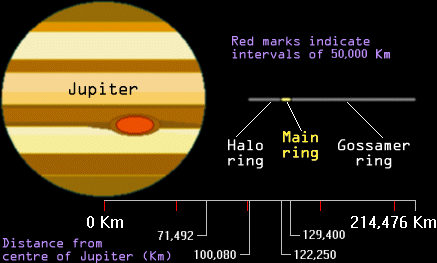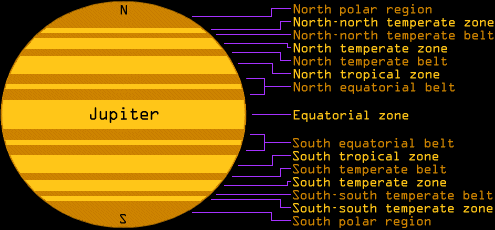Jupiter
![]()
Jupiter is the largest planet in the Solar System. It contains more than double the mass of all the other planets in the Solar System put together. In the image below, taken by NASA's Cassini spacecraft, the Great Red Spot (GRS) is clearly visible in the southern hemisphere.
| Siderial Period |
Perihelion (AU) |
Aphelion (AU) |
Inclination (degrees) |
Axial Tilt (deg) |
Axial Period (d, h, m) |
|---|---|---|---|---|---|
| 11.86 y | 4.95 | 5.46 | 1.3 | 3.12 | 0, 9, 55.5 |
| Equatorial Diameter (km) |
Oblateness | Mass (Earth = 1) |
Density (water = 1) |
Albedo (geom.) |
No. of Satellites |
| 142, 985 | 0.065 | 317.83 | 1.3 | 0.52 | 16 + R |
Ring system
Jupiter has a set of faint rings. The Main ring has a sharp outer edge at approximately 129,400 Km from the centre of the planet. The image below illustrates that faint banding is present within the Main ring.

[ NASA / JPL / Caltech ]
The ring system is divided into three bands. The cross-section below illustrates the ring system to scale (in terms of radial distance from the centre of Jupiter). Only the Main ring was imaged by Voyager 2. (Diagram based on data from the NSSDC.) The rings have a low albedo of only 0.015, which explains why they are not easily observed from Earth.

Three satellites orbit at distances similar to those constraining Jupiter's ring system. Metis and Adrastea orbit at 128,000 and 129,000 Km (respectively) from the centre of Jupiter, at distances similar to that of the Main ring (see diagram above). Amalthea orbits at 181,000 Km, at a distance roughly equivalent to the centre of the Gossamer ring. The next satellite out, Thebe, orbits around 6,000 Km beyond the outer edge of the Gossamer ring.
Cloud bands
The bands of dark and light clouds on Jupiter are a distinctive feature of its atmosphere. In fact, they represent regions of varying pressure; the light bands are high-pressure 'zones', and the dark bands are low-pressure 'belts'. Jupiter has such a fast rotation rate (of only 9 h 55 min) that the zones and belts are stretched around the planet, forming the bands. The diagram below illustrates the bands and their names. (Based on a diagram by McLellan, 1999.) Through most telescopes the observer sees an inverted image, so the northern belts and zones would appear to be in the southern hemisphere, and vice versa.

Jupiter's proximity to the Sun, compared to the distances of the other gas giants, means that a great deal of turbulence occurs within the zones and belts. Consequently, they are never so clearly defined relative to each other as in the diagram (see the Cassini image above).
Missions to Jupiter
For a list of missions to Jupiter see the links page.
